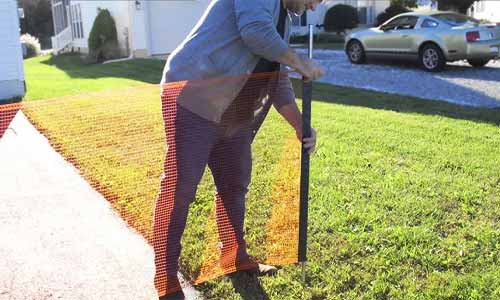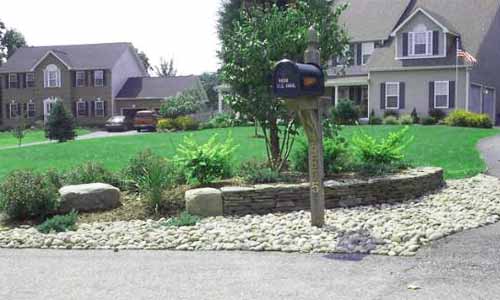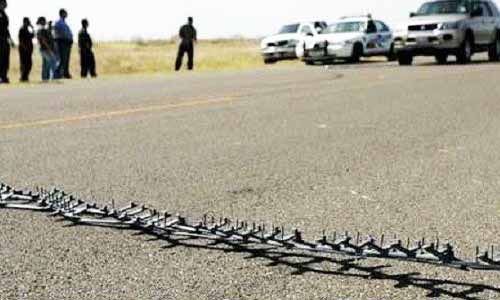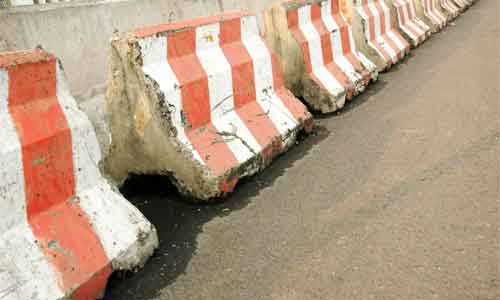How to Keep Cars From Parking on My Lawn?

Every time your neighbor hosts a block party and their friends use your lawn as a parking space, it’s not unusual to see tire ruts on your lawn. You can erect warning signs and barricades at the edge of your yard to deter this form of trespassing (overspill parking) that causes harm to your lawn grass. Fences, bushes, driveway guards, parking posts, and boulders are a few effective barriers.
10 Best Barriers to Keep Cars off Grass
The barriers to keep cars off grass and prevent them from driving onto lawns are visible to drivers and strong/firm enough to remain in place when a car strikes. Here is a detailed explanation of the 10 barriers you may use to barricade and define your lawn area so that cars stay off it.
1. Fences

Depending on your sort of fence, a basic fence or wall might provide some privacy while keeping cars and visitors out of your yard. A low-lying timber fence, a brick wall fence, and a high barbed wire fence are a few alternatives. Furthermore, should you decide to do so, you can choose a retractable safety fence rather than a permanent one.
These fences include ground stakes, so they stay in place and come in various colors to match different types of landscape aesthetics. Before building a fence around your yard, find out from your neighborhood’s residential management committee whether such outside buildings are permitted there.
2. Driveway Netted Guards

A driveway guard is a form of safety netting that can be installed on either side of the driveway to stop cars from straying onto the lawn. It is comparable to the safety fence mentioned before because it is retractable and may be moved sideways to the necessary width.
By placing sticks on the ground for the guard to press against, you may also obliquely slant a netting driveway guard like Sunnyglade around the corners of your yard. To complement various outdoor design sensibilities, netting driveway guards are typically supplied in various colors.
Brightly colored driveway guards are easier to see, especially at night when the driver’s vision may be impaired in the dark.
3. Driveway Rocks and Boulders

To keep their grass safe from automobiles, homeowners frequently use driveway rocks to create a barrier around their lawn. Unruly neighbors should stay off your grass because they are typically large enough to harm automobile bumpers and undercarriages. Real rocks or fiberglass-made artificial boulders can be used to build this barrier.
Real rocks are difficult to move since they are heavy, but they improve the natural aesthetics of your environment and blend in well with the nearby gardens and lawns. However, since they are fashioned to resemble real rocks and have a similar feel and form, artificial boulders provide a more affordable option.
Be aware to not spread the rocks on your lawn except the edges of your yard otherwise you have to remove the rocks from the lawn before you mow so they wouldn’t damage your lawn mower while mowing the lawn. Despite lightweight fiberglass, these rocks have ground anchors to keep cars from toppling them.
4. Spike Strips

Spike strips can be easily installed to deter vehicle occupants from parking on your grass. Tires on moving vehicles will instantly lose air pressure upon contact with the sharp spikes. Additionally, you can paint the strips in a color of your choice to increase the curb appeal.
Please consult with your local residential association before installing spike strips around your yard; some do not authorize their installation owing to the danger they pose to children and pets. Spike strips are a good vehicle barricade material, but because they frequently lead to conflict, you should only use them as a last resort.
5. Concrete Pyramid

Installing concrete pyramids is another way to discourage car owners from parking on your grass. These are normally placed along the edge of the lawn and feature bases with spikes that hook to the ground to create a sturdy barrier. They also come in reflective colors, most often white, to increase their visibility to vehicles. Despite their effectiveness, concrete pyramids are frequently costly.
6. Hedges

Hedges like Patio Paradise are an excellent choice for boosting your yard privacy while protecting your lawn from intrusive vehicles. Hedges are a fantastic technique to safeguard your lawn. You can choose an artificial hedge or a natural hedge (living fence) but consider their benefits and disadvantages before choosing one.
For instance, a natural hedge, which is comprised of bushes and trees and keeps cars off your grass, enhances the appearance of your property. Reaching full adulthood is difficult since it takes time and effort.
An artificial hedge, especially one with a boxwood design, is more affordable, quicker, and simpler to assemble or disassemble. You can tell the difference up close, even though it will appear to be a natural edge from a distance.
7. Parking Posts

Reflective color strips are frequently painted on parking posts and bollards to increase the visibility of the edge of the lawn at night and lessen the probability that vehicles may strike the posts. Meanwhile, metal and steel parking poles, often permanently set on concrete bases, are typically solid enough and won’t be knocked over by automobiles.
To prevent cars from passing through the spaces between parking posts, place them close together (no more than 2 feet apart) along the perimeter of your yard. However, the installation of parking posts along the edge of your lawn may be prohibited in some areas. Be sure to verify with the relevant authorities before doing so.
8. Trees

A variety of unwanted automobiles can be repelled by planting trees on your lawn. For example, if you want to discourage people from parking on your lawn, put trees in the middle or around the perimeter of your yard. You may also plant them singly or in groups in various lawn-related locations. Trees enhance your house’s aesthetic appeal and keep cars off your lawn.
9. Parking cones

Parking cones are among the most affordable and straightforward barriers to keeping cars off the lawn. They are also among the greatest obstacles. Due to their silver or white stripes, these objects are in vivid orange light at night. They convey that you don’t want cars on your grass, and you can easily obtain them from a hardware store in your neighborhood or online.
10. Signs

Signs are a popular choice because it is often the initial option for most homeowners. The effectiveness of old-fashioned signs like “stay out” or “no trespassing” has decreased with time. However, humorous solutions are available, such as placards containing profanity or jokes.
On the other hand, some people would prefer a more straightforward modern sign like “Please Do Not Park On Grass.”Post-security sirens and signage to deter passing vehicles and individuals along the border of your yard.
How to Repair Lawn Damage Caused By a Car?

If the damage has already happened and your grass has ruts, don’t lose hope; you can still fix the lawn. Use a spading fork to pry the soil that has been compacted to release shallow ruts that are no deeper than four inches. To separate the compacted earth, the fork should be held at a 45-degree angle.
You should lift the soil and sod on top of it by approximately an inch by repeatedly pushing the spade fork back and forth. The area that is being repaired will level out with the rest of the lawn as the soil settles later. After that, add a soil mixture to the rut after loosening the earth a little more.
Your lawn’s rut-repair project’s success or failure will be mainly influenced by the soil blend you choose. You should mix One part soil and one part of compost (or one part sand) 50/50 for the best results. Because the roots can reach deeper into the earth when the soil is well-aerated, this allows for deeper grass root development. Roll back the sod over the fresh topsoil mixture to reseed bare areas.
Conclusion
Make sure you choose best barriers to keep cars off your grass is both functional and, at the very least, preserves, if not improves, the aesthetic appeal of your lawn. There are options available to you, some of which are permanent and others that are retractable; you must choose the one that best suits you. I hope this article helps you and you have read the best barriers to keep cars off the grass.






